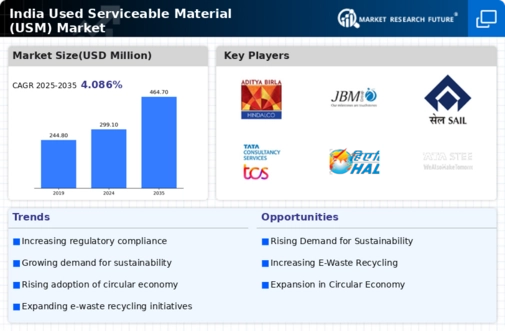Market Growth Projections
The Global India Used Serviceable Material USM Market Industry is poised for substantial growth, with projections indicating a market size of 12.5 USD Billion in 2024 and an anticipated increase to 25 USD Billion by 2035. This growth trajectory suggests a compound annual growth rate of 6.5% from 2025 to 2035. Such projections highlight the increasing recognition of the value of used serviceable materials across various sectors, driven by sustainability initiatives, regulatory support, and technological advancements.
Rising Awareness of Circular Economy
The concept of a circular economy is gaining traction within the Global India Used Serviceable Material USM Market Industry, as stakeholders recognize the benefits of reusing materials. This paradigm shift encourages businesses to rethink their production processes and waste management strategies. By integrating USM into their operations, companies can reduce costs, enhance brand reputation, and contribute to environmental sustainability. The increasing awareness of circular economy principles is likely to drive market growth, with projections indicating a market size of 25 USD Billion by 2035.
Government Initiatives and Regulations
Government initiatives play a pivotal role in shaping the Global India Used Serviceable Material USM Market Industry. Regulatory frameworks aimed at promoting recycling and responsible waste management are being implemented across various sectors. These regulations not only encourage businesses to adopt USM practices but also provide incentives for compliance. For instance, the introduction of policies that mandate the recycling of specific materials has led to increased participation in the USM market. As a result, the industry is expected to grow significantly, with projections indicating a market size of 25 USD Billion by 2035.
Technological Advancements in Recycling
Technological advancements are transforming the Global India Used Serviceable Material USM Market Industry by enhancing the efficiency and effectiveness of recycling processes. Innovations in sorting, processing, and repurposing materials are enabling industries to recover a higher percentage of usable materials from waste. For example, the adoption of AI and machine learning in waste sorting has improved accuracy and reduced contamination rates. These advancements not only streamline operations but also contribute to cost savings, making USM a more attractive option for businesses. This trend is likely to support a compound annual growth rate of 6.5% from 2025 to 2035.
Growing Demand for Sustainable Practices
The Global India Used Serviceable Material USM Market Industry experiences a surge in demand driven by the increasing emphasis on sustainability. As industries seek to minimize waste and enhance resource efficiency, the utilization of used serviceable materials becomes a viable solution. This trend is particularly pronounced in sectors such as manufacturing and construction, where the recycling of materials can significantly reduce costs and environmental impact. In 2024, the market is projected to reach 12.5 USD Billion, reflecting a growing recognition of the importance of sustainable practices in industrial operations.
Increasing Industrialization and Urbanization
The rapid pace of industrialization and urbanization in India is significantly influencing the Global India Used Serviceable Material USM Market Industry. As cities expand and industries proliferate, the demand for materials rises, leading to an increased focus on recycling and reusing existing materials. Urban areas generate substantial waste, which can be repurposed as USM, thereby reducing the need for virgin materials. This shift not only addresses resource scarcity but also aligns with global sustainability goals. The market's growth trajectory reflects this trend, with a projected value of 12.5 USD Billion in 2024.

















Leave a Comment